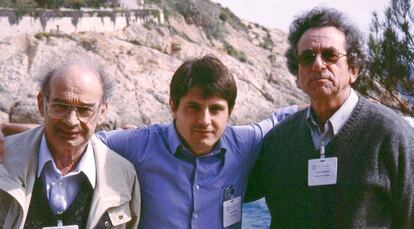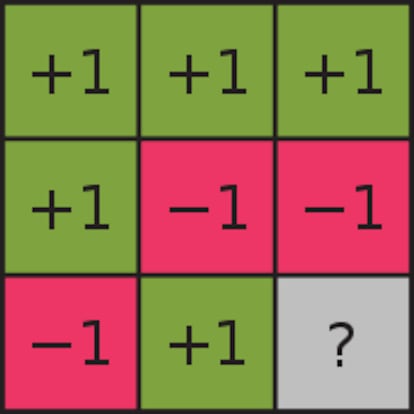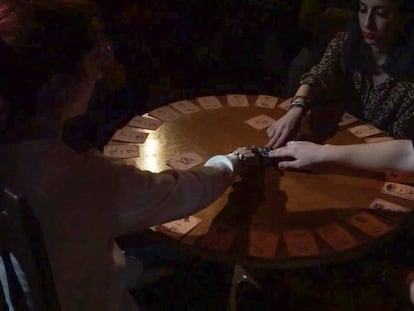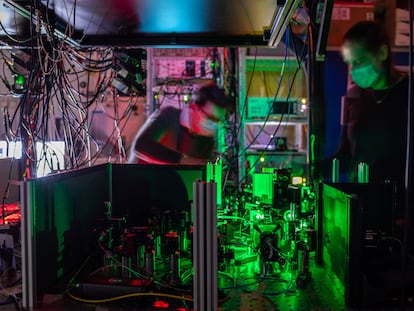Researchers use a game to demonstrate quantum pseudotelepathy
The experiment is based on an approach developed by Spanish physicist Adán Cabello

One of the most fascinating properties of quantum physics is the physical phenomenon of entanglement, which allows spin (or some other effect) in one particle (often referred to as Alice) to instantly affect another particle (Bob), even though they are physically far apart. This property is key to one of the most promising applications of this branch of science – computation. But its fundamentals are still being studied. Chinese researchers believe they have demonstrated something called “quantum pseudotelepathy” in a game-based experiment. Their experiment, described in a recent Science article, is based on work by Adán Cabello, a theoretical physicist at the University of Seville (Spain) who spelled out the game in 2001 (Physical Review Letters).
The team of researchers led by Jia-Min Xu (University of Science and Technology of China) recently published the results of their experiment in Physical Review Letters. The experiment used a magic square game created in the 1990s by David Mermin (Cornell University, New York, USA) and Asher Peres (Israel Institute of Technology, Israel). “It’s not telepathy or magic – it’s physics,” explains Cabello. “It’s a game that’s impossible to win every time unless you use a special form of quantum nonlocality that we call ‘all-or-nothing’ nonlocality. Now it’s called quantum pseudotelepathy, a term that has attracted a lot of attention. The experiment uses a set of measurements discovered by Peres and Mermin, which can be placed in a 3 x 3 table, sometimes called the magic square,” said Cabello.
Jia-Min Xu’s team believes it has found one of the keys to quantum physics. “We conducted a faithful experimental demonstration of quantum pseudotelepathy via playing the nonlocal version of the Mermin-Peres magic square game, where Alice and Bob cooperatively fill in a 3 x 3 magic square. We adopt the hyperentanglement scheme and prepare photon pairs entangled in both the polarization and the orbital angular momentum degrees of freedom, such that the experiment is carried out in a resource-efficient manner. Under the locality and fair-sampling assumption, our results show that quantum players can simultaneously win all the queries over any classical strategy.”
Quantum information scientist Anne Broadbent (University of Ottawa, Canada) remarked on pseudotelepathy in a Science article, “We are seeing something that has no classical equivalent.”
Cabello says: “It’s not a name I like, but it does look like telepathy… Imagine that Alice and Bob are isolated in different locations and have no way of communicating. In the game, a referee asks them to put a 1 or -1 in the 3 x 3 table boxes. Alice has to fill in three boxes in the row indicated by the referee, and the product of her three numbers must always be 1. For example, it’s OK to put 1, -1 and -1, but not -1, 1 and 1. Alice and Bob don’t know which boxes the other has to fill in. They win if they write the same number in the box shared by Alice’s row and Bob’s column, and lose if they write different numbers. Without quantum physics, they can win a maximum of eight out of nine times. But quantum physics enables them to win every time. Without knowing anything about quantum physics, one might conclude that Alice and Bob are communicating telepathically. However, all they are doing is measuring systems that they prepared before starting the game.”

Cabello distinguishes the experiment from other nonlocality experiments. “Normal experiments [using quantum physics] enable magic square games to be won more frequently than is possible without quantum physics. However, this experiment demonstrates how the players can win every time. This makes it more interesting. [Albert] Einstein, who was an avowed opponent of quantum physics, would have been in for a surprise,” said Cabello. “Moreover, it’s a more difficult experiment to conduct because using a single pair of entangled qubits [quantum bits] in each move is insufficient – you have to use two pairs of hyper-entangled qubits.”
Using Cabello’s 2001 approach, the Chinese researchers were able win 93.84% of the 1,075,930 games played. If the experiment’s limitations are taken into account, Alice and Bob won 100% of the time. Xi-Lin Wang (Nanjing University, China) a co-author of the study, believes that they can “improve the quality of hyper-entangled photons.”
Anne Broadbent explains in Science that “if the game were incorporated into a computer program, it would enable checking whether a quantum computer is manipulating the entangled states as it should.”
Three quantum cryptography experiments
After months of revisions, the Chinese experiment was published at the end of July, coinciding with a flurry of activity in the field of quantum physics. In three papers published simultaneously (two in Nature and one in Physical Review Letters), researchers demonstrated the feasibility of device-independent quantum cryptography, which is a protocol that uses quantum physics for secure communications. Antonio Acín (Institute of Photonic Sciences, Barcelona, Spain), explains in Physical Review Letters, that users [of this protocol] “don’t need to model the devices – they can be treated as black boxes.”
The three quantum cryptography experiments were conducted in the United Kingdom, Germany and China, and use entangled ions, atoms and photons, respectively. Adán Cabello says, “The Oxford (UK) experiment is the best of the three because it’s the only one that really manages to generate a secure [cryptographic] key. The Munich (Germany) experiment is spectacular because it involves a greater distance, and the Chinese experiment is the most interesting for the future because it’s the only one that uses photons, which is what we are actually going to use for real-world communications.”
Acknowledging the difficulty of finding real-world applications for these scientific advances, Cabello says, “It’s fantastic that there are experiments that have attained this level of sophistication in the reproduction of quantum mechanics.” Charles Lim (National University of Singapore), who participated in the Munich experiment says, “These demonstrations are a breakthrough for cybersecurity.” Jean-Daniel Bancal (French National Center for Scientific Research - CNRS), who participated in the Oxford experiment, adds that they can provide security “against adversaries with unlimited processing power or even a quantum computer.”
Tu suscripción se está usando en otro dispositivo
¿Quieres añadir otro usuario a tu suscripción?
Si continúas leyendo en este dispositivo, no se podrá leer en el otro.
FlechaTu suscripción se está usando en otro dispositivo y solo puedes acceder a EL PAÍS desde un dispositivo a la vez.
Si quieres compartir tu cuenta, cambia tu suscripción a la modalidad Premium, así podrás añadir otro usuario. Cada uno accederá con su propia cuenta de email, lo que os permitirá personalizar vuestra experiencia en EL PAÍS.
¿Tienes una suscripción de empresa? Accede aquí para contratar más cuentas.
En el caso de no saber quién está usando tu cuenta, te recomendamos cambiar tu contraseña aquí.
Si decides continuar compartiendo tu cuenta, este mensaje se mostrará en tu dispositivo y en el de la otra persona que está usando tu cuenta de forma indefinida, afectando a tu experiencia de lectura. Puedes consultar aquí los términos y condiciones de la suscripción digital.
More information
Últimas noticias
‘Fallout’ or how the world’s largest company turned an anti-capitalist apocalyptic Western into a phenomenon
From inflation to defending migrants: Eileen Higgins and Zohran Mamdani inaugurate the new Democratic resistance against Trump
EU’s prestige at stake with proposal to fund Ukrainian war effort with Russian assets
Mustafa Suleyman: ‘Controlling AI is the challenge of our time’
Most viewed
- ‘El Limones’ and the growing union disguise of Mexican organized crime
- Christian Louboutin: ‘Young people don’t want to be like their parents. And if their parents wear sneakers, they’re going to look for something else’
- ‘We are dying’: Cuba sinks into a health crisis amid medicine shortages and misdiagnosis
- The low-cost creative revolution: How technology is making art accessible to everyone
- A mountaineer, accused of manslaughter for the death of his partner during a climb: He silenced his phone and refused a helicopter rescue











































